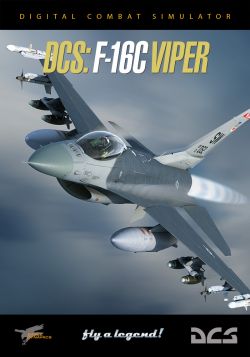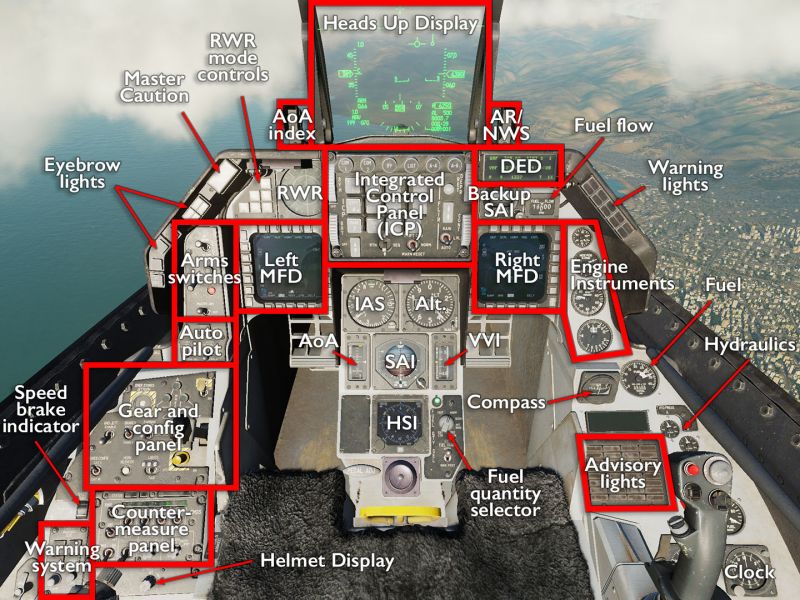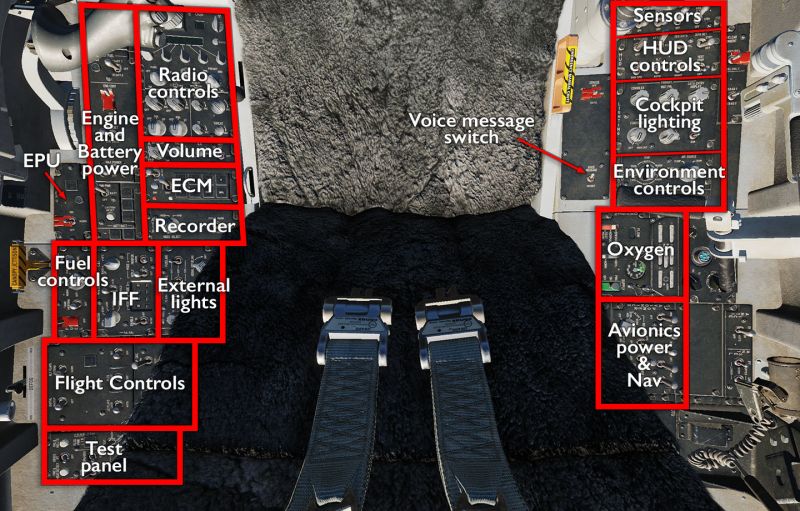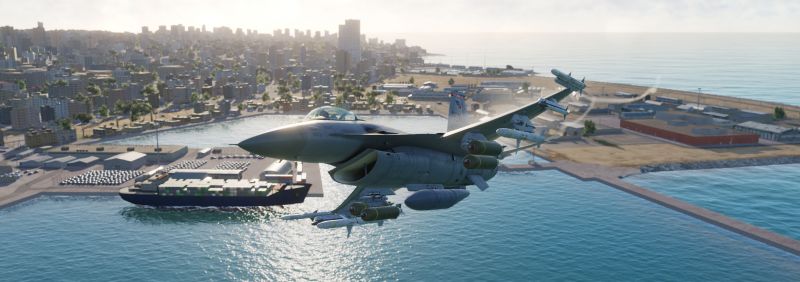F-16C Viper
| This is an alpha module.
This module is still being developed and is missing central features and equipment options. While it is playable, it may have major bugs, and procedures may have inconsistent or unexpected results. The intrepid and very interested may want to buy it; others should probably wait for a more stable or complete release. |
Once upon a time, there were some deep rumblings within the defence establishment from a self-proclaimed “Fighter Mafia” that claimed that post-WWII aircraft development had taken a wrong turn. Instead of the on-going trend of expensive higher-tech, missile-laden, huge-engined multi-purpose fighters and bombers, this group advocated cheap, simple, nimble, single-purpose aircraft focused on two key roles: in-close dogfighting (because BFR was a fool's errand) and close air support where energy-manoeuvrability (E-M) was the one performance measure to rule them all.
The result of the Mafia's efforts were three aircraft: the A-10, the F-15, and the F-16. The A-10 ended up as a high-tech, missile-laden, far-from-single-purpose (if still CAS-focused) sensor array and bomb truck. The F-15 became a costly, high-tech, missile-laden, huge-engined BFR interceptor (and later a multi-purpose bomber as well, just to rub it in). And the F-16 — the finest example of their core tenets — became a high-tech, missile-laden, huge-engined, BFR/dogfighter/fighter-bomber platform onto which every conceivable piece of aircraft tech could be (and was) bolted, creating the multiest-rolliest thing in the sky. Zero for three for the Fighter Mafia, but still a highly impressive legacy.
The F-16C Viper is the last DCS module to complete the trifecta and an attempt give people a reason to finally abandon Falcon BMS. It is also, almost ironically and in spite of how it evolved over the years, still the aircraft that most closely matches the initial ideas of the E-M fighter: a ridiculously manoeuvrable dogfighter that just so happened to be an excellent airframe for a ton of other roles.
Features
Much like — some would argue much more than — the F/A-18 that was its main competition in the Lightweight Fighter trials, the F-16C is a multi-role fighter, working as the USAF bulk workhorse for many decades. As such, again much like with the Hornet, a full feature list would become ridiculously long. The main highlights are:
- Almost unrivalled manoeuvrability.
- Moon-rocket engine performance — if you somehow get outmanoeuvred, just fly away and try again.
- A superbly user-friendly HOTAS and MFD setup.
- A highly capable and almost as user-friendly in-your-face interface in the form of the Integrated Control Panel (ICP) and Data Entry Display (DED).
- Backup steam gauges (in case the fancy displays go down) that are still almost reasonably and usefully placed.
- A highly capable navigation and sensor suite tied in with datalinks to keep your situational awareness high.
- Helmet-cued AIM-9X over-the-shoulder IR missiles for up-close work and AMRAAMS for BFR duty.
- HARMs and CBU-97s for SEAD and DEAD missions.
- More Mavericks than any rivet-counter finds reasonable.
Missing features
The F-16C Viper is marked as Early Access in the DCS store for very good reasons. A lot of forum drama has been caused by a constant push and pull between work on the Viper and the completion of the Hornet module, and many systems and tools familiar to old BMS players are still missing — more still will never come.
- Most of the fancy navigation trickery on the DED (VIP and VRP offsets, optimal cruise modes, mark points etc).
- Proper sensor integration with HUD marking, cursor zero, and hand-off modes.
- All forms of inertially guided weapons (JDAM:s, JSOW:s, CBU guidance kits).
- Advanced HARM target modes and the HARM Targeting System pod.
- Proper weapon setup and HSI and MFD preprogramming via data cassette (some of it is cheated and automatically populated, such as SAM locations on the HSI).
- Ground radar.
In particular, ED has stated that some much-loved features from BMS will never come because the block simulated in the Viper module never had them:
- GBU-39 SDB:s
- JSOW-B:s
- Terrain-following radar and LANTIRN overlays.
Flying the F-16C
The F-16 was the first aircraft to use a dynamically unstable flight dynamic under the control of a fly-by-wire system to create a highly agile yet highly controllable aircraft. While it is very quick to respond to inputs, and was designed from the start to let rapid rolls and tight 9G turns, it is not actually twitchy or nervous, and will respond to a steady hand with very stable and controlled flight. It is entirely possible to overwhelm the FBW system and end up in a very bad situation, but it takes some doing, and for the most part it is just a matter of suggesting a direction for the plane to go and it will do so.
This is made especially evident in two ways: one is when landing, when much like any other FBW aircraft, you only really need to dial in the proper AoA (as indicated by the indexer next to the HUD and the AoA staple in the landing HUD screen) and the Viper will maintain that angle. Unless there's a lot of wind to parry, you only really need to use the throttle to move the velocity vector up and down to where it needs to be. The other is just plain ferry flight, where a highly competent autopilot can dutifully follow waypoints for you or even go into circling patterns around fixed points if you ask it to, leaving you to fully attend to sensor usage and weapons delivery.
Cockpit overview
Getting into the air
In spite of being a full-sim aircraft (albeit still an incomplete one) and a rather advanced one at that, given all the extra bits that have been bolted onto the airframe over the years, the F-16C is surprisingly easy to get going. As with most modern aircraft, its navigation alignment process can take a while, but the rest is very familiar and brief to anyone who's gotten into the DCS swtich-flipping. It is less involved than the F/A-18C and a far cry from the multiple interdependent systems A-10C.
As always the RWinHome “cheat” key combo is available to automate the start-up process, and the manual and Chuck's guide linked below give a full account of the procedure. The broad strokes are:
- Battery power and flight control system on.
(Main Power switch to Battery, Flight Control test switch to Test.) - Engine start.
(Jet Fuel switch to Start 1, throttle out of detent.) - Power everything.
(Main Power switch to Main Pwr, turn on Parking Brakes, all Avionics, all Sensors, Countermeasures, Radio, IFF, Lights, HUD brightness.) - Check and note your position on the map (because there is no kneeboard option for this unlike every other module) and get ready to enter it in the DED
(LIST > 6 INS — note the pre-stored position and altitude.) - Start the INS alignment — once started, you have two minutes to enter or confirm the position shown in the DED INS page.
(INS dial to NORM, use the number keys and the dobble switch on the ICP to move between and change the starting position.) - While the INS is aligning (the INS page will count down the readiness state and finally say 6 RDY on the top row when done), close up the cockpit and set up everything else.
(Oxygen, radios, weapon loadout, waypoints, and all that jazz.) - When aligned, move the INS switch to NAV, release the parking brake, and waddle off into the air per normal procedures.
Shooting something
BVR engagement
Using the HARM
Links and files
- Chuck's F-16C Viper guide at Mudspike.
- DCS: F-16C Viper in the DCS shop.
More information
- General Dynamics F-16 Fighting Falcon on wikpedia.
- F-16 Fighting Falcon on globalsecurity.org
- Matt Wagner's F-16 Viper series.
- Wonkotron's Quick Usage Guide






